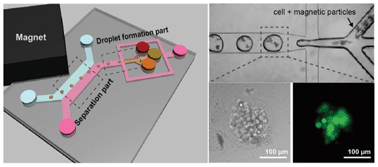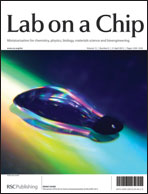The importance of creating a three-dimensional (3-D) multicellular spheroid has recently been gaining attention due to the limitations of monolayer cell culture to precisely mimic in vivo structure and cellular interactions. Due to this emerging interest, researchers have utilized new tools, such as microfluidic devices, that allow high-throughput and precise size control to produce multicellular spheroids. We have developed a droplet-based microfluidic system that can encapsulate both cells and magnetic nanoparticles within alginate beads to mimic the function of a multicellular tumor spheroid. Cells were entrapped within the alginate beads along with magnetic nanoparticles, and the beads of a relatively uniform size (diameters of 85% of the beads were 170–190 μm) were formed in the oil phase. These beads were passed through parallel streamlines of oil and culture medium, where the beads were magnetically transferred into the medium phase from the oil phase using an external magnetic force. This microfluidic chip eliminates additional steps for collecting the spheroids from the oil phase and transferring them to culture medium. Ultimately, the overall spheroid formation process can be achieved on a single microchip.

You have access to this article
 Please wait while we load your content...
Something went wrong. Try again?
Please wait while we load your content...
Something went wrong. Try again?


 Please wait while we load your content...
Please wait while we load your content...